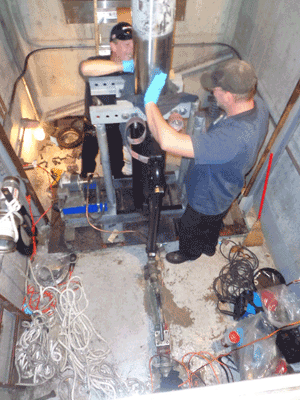South San Francisco Station shows complexities behind elevator, escalator maintenance

A crew working to replace a plunger and cylinder
on the elevator at South San Francisco Station.
If you’ve traveled through BART’s South San Francisco Station recently, you’ve probably noticed the elevator is out of service, and unfortunately it has been for some time -- since Aug. 20, to be exact.
The good news is we have specialists dedicated to repairing the elevator and it should be back up and running before the end of the month.
A HIGH GOAL FOR ELEVATORS
BART sets a very high goal for elevator availability because of the impact it has on our passengers with disabilities. Our latest quarterly performance report shows our station elevator availability is at +98%. We are always striving for 100%, but sometimes things break down. This particular elevator has proven to be a stubborn fix.
The repair has required a complete replacement of the hydraulic piston and cylinder assembly -- components that allow the car to move vertically. Ordering these parts takes time because the cylinder has to be precision built to match the piston. BART even paid extra to have the items expedited. Now that we have the parts, we have to very carefully assemble the two separate pieces for reinstallation. The cylinder assembly is in a 35-foot-deep pit in the elevator shaft, and is packed in with sand. The alignment of the cylinder assembly is also critical to get right. In addition, we have to rig the elevator car free from the piston and hang it in the hoistway. This is no small fix.
NO SMALL FIX
You may have also noticed at the South San Francisco Station, we’ve switched the directions of both escalators. We understand these types of changes can be confusing or frustrating but both escalators are working, with one heading up and one heading down. This new configuration may even decrease the number of steps you have to take on your trip. On the other hand, depending on where you are going, it may increase the number of steps.
This temporary change in direction has been implemented to prevent an even larger inconvenience.
We must operate this particular escalator in a new direction right now due to a mechanical issue. The escalator has a bad thrust bearing. The thrust bearings are directional, and reversing the unit takes the stress off the bad bearing and loads the good bearing. If we continued to run the escalator in the up direction it will likely fail and we very well may end up with one of the two escalators out of service -- at the same time as the elevator being down. If we repair it now, we would have to take the escalator out of service for a period of time to make the complex repairs. Both scenarios would lead to a tremendous inconvenience for passengers because it would result in both an escalator and an elevator out of service -- a scenario we want to avoid.
Once the elevator is repaired, we will undertake the planned repair of the escalator thrust bearing to allow future reversal of the units. Having the ability to reverse the unit is the key to a healthy escalator. We have to be able to change directions so we have equivalent gear wear for up and down directions. Think of it as flipping your mattress or rotating your tires. If an escalator is run only in one direction for a long time, you can never reverse its direction due to unbalanced gear wear.
A PLAN TO ADDRESS THE PROBLEM
So there you have it. We have two unfortunate coincidences at the same station with a strategic plan in place to address the problem: Fix the broken elevator unit as quickly as possible while maintaining reliable escalator service during the time the elevator is out; once the elevator is back up, move on to addressing the escalator problem.
We apologize for the inconvenience these problems have put on our customers. The good news is, the elevator will be back in service soon and, unlike an unexpected traffic jam that catches commuters off guard, elevator outages can be taken into account when planning your commute.
Planning ahead is the key to navigating the BART system when you require the use of an elevator.
HOW TO GET ELEVATOR INFO
BART offers many sources of information on elevator status so customers can plan their trips around outages:
- Elevator status hotline 510-834-LIFT or 888-2-ELEVAT.
- Elevator status advisories via web, mobile web, email and text messaging. Passengers can get more info and sign up for these alerts by visiting http://bart.gov/advisories/.
- The Operations Control Center makes system-wide public address announcements about elevator status. You’ve probably heard these updates when riding on a train and wondered why we are constantly providing updates. This information is vital for those who cannot use an escalator or stairs).
- Electronic elevator status signs at every primary station agent booth.
COMMON ELEVATOR PROBLEMS
In general, elevators have a variety of failure modes due to their complexity. Here are the most common reasons an elevator goes out of service:
- Door mechanisms are among the most frequent, including debris fouling the track
- Problems with seismic devices
- Problems with electronic control systems and sensors
- Problems with hydraulic pumps and piston glands for hydraulic units
- Vandalism
- Problems with emergency telephones (they must be working at all times)
Updated Monday, Nov. 26, to correct typos and restore dropped word, and to add photograph.